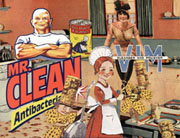|
Left in the Dust
By Ted Kleine
Dust: A History
of the
Small & the Invisible
By Joseph A. Amato
University of California Press
250 pages, $22.50
Does Mr. Clean really have a place in history alongside Galileo and Pasteur? He does in Joseph A. Amato's epic essay, Dust: A History of the Small & the Invisible, which insists that a society's level of civilization can be measured by the glow on its kitchen floors.
 |
|
Credit: Rinnert
|
In the Middle Ages, centuries before Proctor met Gamble, "men and women were intimate with dust in ways beyond contemporary imagination." Dust rose from dirt roads and rimed hair and skin, marking peasants as a grubby, dark-complexioned race. As soot, it blackened the walls of huts. People were even intimate in dust: "All over the world, people of times past fell asleep and woke up in dusty beds."
To be covered with dust was to be close to the earth, an association that has never helped anyone's social standing. "Filthy" and "dirty" became synonyms for immorality, and "rising from the muck and mire" meant advancement in the world. The upper classes invented complicated manners to separate themselves from "rustics" who wiped snot on their sleeves.
Dirt and dust were shunned partly because they smelled so putrid, but also because even the ancients had a sense that they harbored disease. The discovery and defeat of viruses, germs and bacteria was the number-one benefit of the world's getting tough on grime. Until the 17th century, dust "was an omnipresent boundary ... between the visible and the invisible." But then came the microscope, and scientists could map the anatomy of the ant and study the lives of single-celled organisms.
Ted Kleine frequently writes for In These Times and the Chicago Reader.
![]()
|
In These Times ©
2000
Vol. 24, No. 12 |
